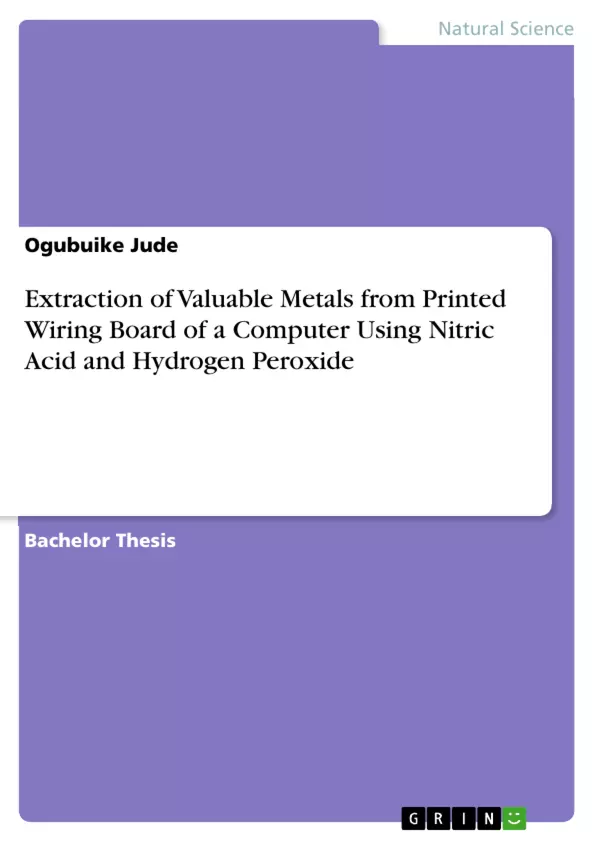This study investigates the recovery of valuable metals in an environmentally friendly way that reduce environmental pollution and human exposure to the toxic chemicals.
The global production of electrical and electronic waste (e-waste) is increasing rapidly and is expected to accelerate globally. Globally e-waste is classified as hazardous material and therefore should be managed properly to avert pollution and human e-waste is one of the waste streams difficult to manage global. In Nigeria, it is expected that the production of e-waste will increase by 60%, therefore, a three-pillar strategy of waste prevention, recycling and reuse has been suggested to minimize the environmental impact and promote the efficient utilization of wasted resource.
Inhaltsverzeichnis (Table of Contents)
- DEDICATION
- ACKNOWLEDGEMENTS
- LIST OF TABLES
- LIST OF ABBREVIATION AND SYMBOL
- ABSTRACT
- CHAPTER ONE
- INTRODUCTION
- BACKGROUND TO STUDY
- STATEMENT OF THE RESEARCH PROBLEM
- JUSTIFICATION
- AIM AND OBJECTIVES
- SCOPE AND LIMITATION OF THE STUDY
- CHAPTER TWO
- LITERATURE REVIEW
- ELECTRONIC-WASTE RECYCLING
- GENERAL DRIVING FORCE FOR E-WASTE PROCESSING
- ENERGY AND RESOURCE CONSERVATION
- E-WASTE PROCESSING
- METALLURGICAL PROCESSES FOR THE EXTRACTION OF METALS FROM E-WASTE
- Hydrometallurgical Processes
- Microbial Biotechnological Approaches To Recover Metals From Waste
- DESIGN FOR RESOURCE (DFR) EFFICIENCY
- CHAPTER THREE
- MATERIALS AND METHOD
- MATERIALS USED
- Equipment Used
- METHODS
- CHAPTER FOUR
- RESULTS AND DISCUSSION
- LEACHING EFFECTS OF STUDIED PARAMETERS ON METALS EXTRACTION
- CONCLUSION
- RECOMMENDATIONS
- REFERENCES
- LIST OF TABLES
Zielsetzung und Themenschwerpunkte (Objectives and Key Themes)
This research project investigates the extraction of valuable metals from discarded printed wiring boards (PWBs) of computers using nitric acid and hydrogen peroxide as leaching agents. The primary objective is to develop a sustainable and efficient method for recovering valuable metals from electronic waste, contributing to environmental protection and resource conservation. This study aims to optimize the leaching process by exploring the effects of various parameters, including acid concentration, oxidant concentration, reaction time, and temperature, on the extraction efficiency of the metals. The research also examines the economic viability and environmental implications of the proposed method.
- Sustainable and efficient extraction of valuable metals from electronic waste
- Optimization of leaching process parameters for efficient metal extraction
- Environmental implications and economic viability of the proposed method
- Contribution to resource conservation and environmental protection through e-waste recycling
- Exploration of the potential of nitric acid and hydrogen peroxide as leaching agents for metal extraction
Zusammenfassung der Kapitel (Chapter Summaries)
Chapter 1 provides a comprehensive introduction to the research project, discussing the background of electronic waste recycling, the statement of the research problem, and the justification for the study. This chapter also outlines the aims and objectives of the research, as well as the scope and limitations of the study.
Chapter 2 delves into a comprehensive literature review focusing on various aspects of electronic waste recycling. This chapter explores the general driving forces behind e-waste processing, emphasizing the significance of energy and resource conservation. It further investigates different methods for e-waste processing, including metallurgical processes, hydrometallurgical approaches, and microbial biotechnological techniques for metal recovery. The chapter concludes with a discussion on Design for Resource (DFR) efficiency, highlighting its role in minimizing the environmental impact of electronic waste.
Chapter 3 details the materials and methods employed in the research. This chapter outlines the materials used, including the specific types of PWBs and the chemicals employed in the leaching process. The equipment used in the study is also described. The methods section provides a step-by-step description of the experimental procedures, including sample preparation, leaching process, and metal analysis. This section also highlights the parameters studied in the leaching process.
Schlüsselwörter (Keywords)
The core keywords and focus topics of this research include electronic waste recycling, metal extraction, hydrometallurgical processes, nitric acid, hydrogen peroxide, leaching, PWBs, resource conservation, environmental protection, and sustainable development. The study emphasizes the recovery of valuable metals from electronic waste, exploring the efficiency and economic viability of using nitric acid and hydrogen peroxide as leaching agents. This research is aimed at contributing to the field of sustainable waste management and resource recovery.
- Citar trabajo
- Ogubuike Jude (Autor), 2019, Extraction of Valuable Metals from Printed Wiring Board of a Computer Using Nitric Acid and Hydrogen Peroxide, Múnich, GRIN Verlag, https://www.grin.com/document/1239246



